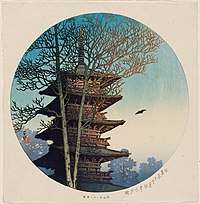Godai (Japanese philosophy)
The five elements philosophy in Japanese Buddhism, godai (五大, lit. "five great"), is derived from tantric Buddhist beliefs. It is perhaps best known in the Western world for its use in Miyamoto Musashi's famous text Gorin-no-sho (The Book of Five Rings), in which he explains different aspects of swordsmanship by assigning each aspect to an element.
Engendered by the ancient I Ching, the Wu xing was developed in China around the end of the fifth century CE. It next moved into Japan, where it took the name of gogyo. In tandeem with the gogyo that emerged out of Chinese Taoism, Buddhism crafted its own version of this "five-elements principle," the godai, with several variations and adaptations.
The Buddhist godai is slightly distinguished from the Chinese Wu xing and the Japanese gyogo by the fact that the elements of wood or metal are replaced by the void or the wind (air) depending on the variant version. Its cycle also begins with the element earth in contrast to gyogo. ...Godai was later incorporated by the esoteric branch of Buddhism Japan during the tenth century CE under the name of gorin (the "five wheels" or the "five rings"). From there, godai and gorin eventually moved into ninjutsu, where this principle of the five elements became an essential aspect of the esoteric ninja teachings (the ninpo-mikkyo).
...At a primary level, the five wheels gave structure to all the ninja combat techniques.
| Classical elements |
|---|
|
Stoicheion (στοιχεῖον) |
|
Wuxing (五行) |
|
Godai (五大) |
|
Bön |
|
Alchemy |
The elements
The five elements are Earth, Water, Fire, Wind, and Void.
[In mikkyo it is taught that] All physical aspects of existence originate from a common source and can be classified in of the godai five elemental manifestations of physical. Chi, or the earth, symbolizes solid matter. Sui, the water, symbolizes liquids. Ka, the fire, is the symbol of combustion, or the elements in an energy-releasing state. Fu, the wind, symbolizes gases. Ku, the void, is representative of the formless subatomic energy that is the basis for the structure of all things. This godai symbolism is also used to describe the emotional nature of human beings, and to provide a symbolic structure for the teaching of effective physical combat principles in ninjutsu.
As such, these may describe an individual's response to direct confrontation, such as in martial arts (including associations with physical center of tension and movement, body vibrations, footwork, one's response to attack, and the attacker's emotional response):[2]
- Chi: stability/stubbornness; holding ground and using strength and presence (source: strength)
- Sui: flexibility/emotionalism; defensive angling and footwork to overextend the attacker before counterattacking (source: power)
- Ka: aggression/fear; using high energy attacks defensively (source: energy)
- Fu: wisdom/love; evasive, elusive methods that redirect attacks away from their targets (source: resiliency)
- Ku: creative/communicative; spontaneous and inventive fighting
Earth

地 Chi (sometimes ji) or tsuchi, meaning "Earth", represents the hard, solid objects of Earth. The most basic example of chi is in a stone. Stones are highly resistant to movement or change, as is anything heavily influenced by chi. In people, the bones, muscles and tissues are represented by chi. Emotionally, chi is predominantly associated with stubbornness, collectiveness, stability, physicality, and gravity. It is a desire to have things remain as they are; a resistance to change. In the mind, it is confidence. When under the influence of this chi mode or "mood", we are aware of our own physicality and sureness of action. This is a separate concept from the energy-force, pronounced in Chinese as qì (also written ch'i) and in Japanese as ki, and written alternatively as 気, 氣, or 气.
Water

水 Sui or mizu, meaning "Water", represents the fluid, flowing, and the formless things in the world. Outside of the obvious example of rivers and the lake, plants are also categorized under sui, as they adapt to their environment, growing and changing according to the direction of the sun and the changing seasons. Blood and other bodily fluids are represented by sui, as are mental or emotional tendencies towards adaptation and change. Sui can be associated with emotion, defensiveness, adaptability, flexibility, suppleness, and magnetism.
Fire

火 Ka or hi, meaning "Fire", represents the energetic, forceful, moving things in the world. Animals, capable of movement and full of forceful energy, are primary examples of ka objects. Bodily, ka represents our metabolism and body heat, and in the mental and emotional realms, it represents drive and passion. Ka can be associated with security, motivation, desire, intention, and an outgoing spirit.
Wind

風 Fū or kaze, meaning "Wind", represents things that grow, expand, and enjoy freedom of movement. Aside from air, smoke and the like, fū can in some ways be best represented by the human mind. As we grow physically, we learn and expand mentally as well, in terms of our knowledge, our experiences, and our personalities. Fū represents breathing, and the internal processes associated with respiration. Mentally and emotionally, it represents an "open-minded" attitude and carefree feeling. It can be associated with will, elusiveness, evasiveness, benevolence, compassion, and wisdom.
Void (Aether)

空 Kū or sora, most often translated as "Void", but also meaning "sky" or "heaven", represents those things beyond our everyday experience, particularly those things composed of pure energy and beyond; the emptiness that the energy is made up of. Bodily, kū represents spirit, thought, and creative energy. It represents our ability to think and to communicate, as well as our creativity. It can also be associated with power, creativity, spontaneity, and inventiveness.
Kū is of particular importance as the highest of the elements. In martial arts, particularly in fictional tales where the fighting discipline is blended with magic or the occult, one often invokes the power of the Void to connect to the quintessential creative energy of the world. A warrior properly attuned to the Void can sense their surroundings and act without using the mind, and without using their "physical senses".
Representations of the godai

Many temples in Japan have beautiful goju-no-to, or five storied towers [pagodas]. Five roofs of graceful curves make the towers architectural beauties...of wooden construction built without any nails or bolts. ...Though they are beautiful, they are not erected merely as architectural ornaments for temples.
The five stories stand for...godai, or Five Greats in Buddhism. They are the elements in the Universe from which are produced all things. ...Thus the towers symbolize the Universe and everything existing in it.
The five elements are also expressed in stone towers gorintō.[3]
The most common representations today of the five elements, outside of martial arts and fictional references, are found in Buddhist architecture. Japanese gorintōes (go-rin-to, the Japanese word of 'go' means 'five', 'rin' means 'ring shape', and 'to' means the 'tower'.) as seen in Zen gardens and Buddhist temples, represent as a Stupa. These have five divisions which represent the five elements, although the five segments can be hard to discern. The bottom-most piece, touching the ground, represents chi; the next section represents sui; ka is represented by the section encasing the lantern's light or flame, while fū and kū are represented by the last two sections, top-most and pointing towards the sky. It is composed from bottom to top of a cube, a sphere, a pyramid, a crescent and something resembling a lotus flower, shapes that also have the meaning described above.
The stone lanterns, that is very similar to the gorinto, is a stone tower of modest size put on a center line for the approach mainly to the Buddhist temples and cemeteries, but the functional meaning of toro is different from the gorinto, to illuminate the approach to the temple as like lighthouses, for the strict Buddhist ceremony at night .
Sources
- Masazumi, Natori; trans. Mazuer, Axel (1681/2010). Shoninki: The Secret Teachings of the Ninja (The 17th-Century Manual on the Art of Concealment), unpaginated. Inner Traditions/Bear. ISBN 9781594776670.
- Hayes, Stephen K. (1981/2003). Warrior Ways of Enlightenment, Vol. 2, p.26. Ohara Publications, Santa Clarita, California. 22nd edition. ISBN 0-89750-077-6
- Joya (2017). Japan And Things Japanese, unpaginated. Taylor & Francis. ISBN 9781136221866.
External links
- Miller, Jeff (June 1996). "5 Element Codes Part 1." Ninjutsu – Ura & Omote.
- Deon de Jongh (2003). Touhkondo: The Way of the Fighting Spirit, p.27. iUniverse. ISBN 9780595279784.